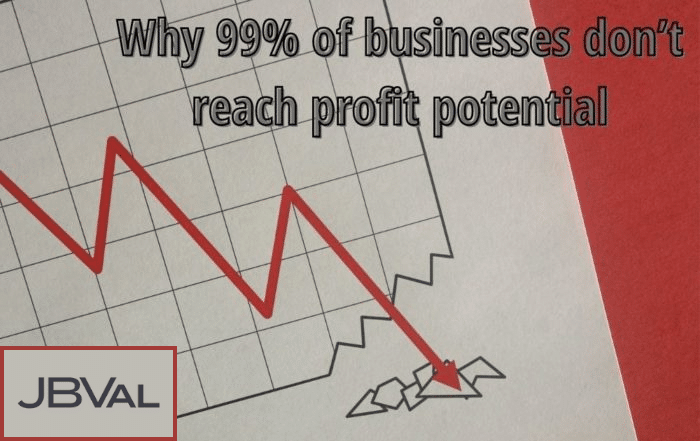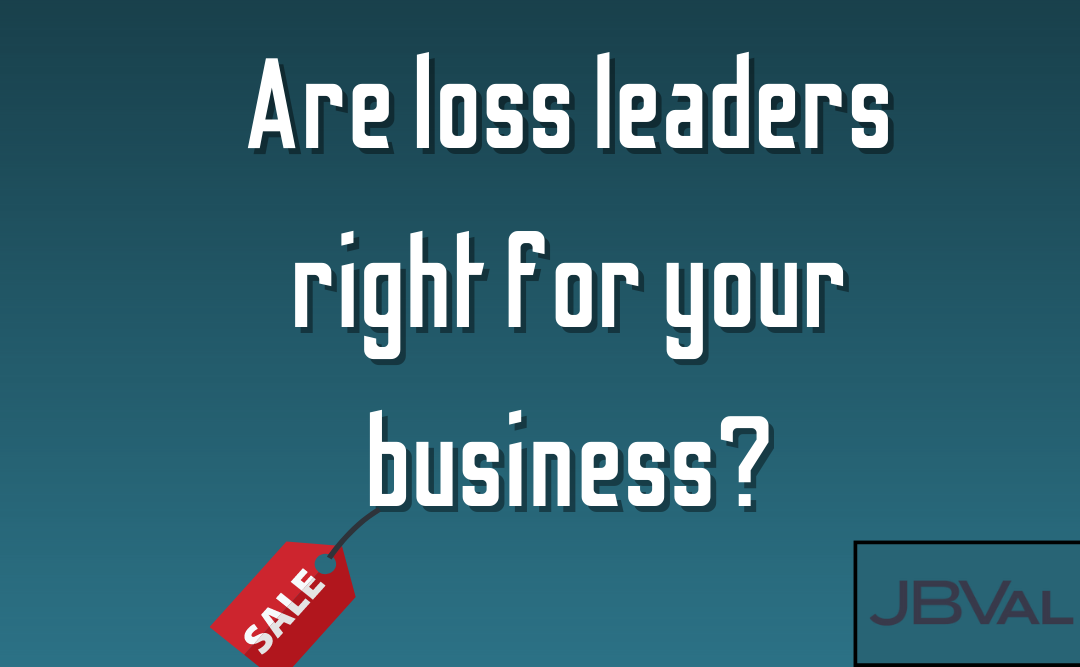
by Kevin Jennings | Jun 21, 2021 | Business Owners
Are you leaving money on the table?
Over the combined 50+ years the team at JBVal has performed valuations, we hear from proud business owners, “This business would be nothing without me.”
It’s inevitable one day, they will not walk in the door. When asked what happens when that day comes, they shrug it off. They realize the business may sell for much less than its true worth.
Too frequently, they are right. The business is worth nothing without them. He or she makes all decisions and is effectively if not in practice CEO, CFO, VP of Sales & Marketing and VP of Operations. And size of business seems unimportant. We’ve seen this in companies from $5 million to $25 million in size.
Is this smart? Is this fair to your family (especially those working in the business)? Your employees?
The obvious answer is no.
Can it be fixed?
The simple answer is yes.
The recipe is simple. The ingredients: a bit of work, time, and the willingness to cede decision making to others. This last ingredient is the hardest for many entrepreneurs. (read more on why you must delegate here)
McDonalds and other successful franchises provide turnkey businesses to franchisees. By turning yours into a turnkey business, your business can be sold for its true worth. It’s been proven over and over, buyers won’t buy a business which lacks a strong management team, one that is not dependent on you!
What do buyers look for?
- Well developed team
- Organizational chart
- Employee retention
- Customer retention
- History of earnings
- Annuity-like cash flows
- Sustainability
Ask yourself honestly, “Would I buy my business?” “Would I want my child to live the life I lived in this business?”
In a series of articles, we will discuss ideas on how to turn your business into a more profitable turnkey business. One that can prosper without you.

by Kevin Jennings | Feb 15, 2021 | Business Owners
Every company wants to increase profitability. The first place they should look is actually not to new leads, but inward at their own operations. 99% of businesses are missing out on potential profits. With minor tweaks, a business owner can begin to realize thousands of dollars or more in his or her pocket. After 35+ years of performing business valuations for thousands of clients, patterns started to arise. The most common areas of profit leaks have become very clear to me. There’s one area I always look to first to discover profit leaks: profitability by customer.
Customer Analysis
Which customers are most profitable to your business? Ask most business owners this and you’ll be met with blank stares. Most businesses treat their target customers the same. But they’re not. Without knowing the different spending patterns and behaviors of different customers, a business can lose thousands or more in potential profit. People within different market segments spend their money differently. This shouldn’t be a surprise. As Donald Norman said, “market segmentation is a natural result of the vast differences among people.” Divide your customer base into as many segments as practical. The more segments you have identified, the better. This may mean dividing up your customers by… Geography, age, industry, size, etc. Find out more on customer analysis from brandwatch.com
Identify the Most Profitable
After segmenting the customer base, understand your KPIs for each segment. Understand which statistics are the biggest factors in profitability and measure those factors for each segment. How much money does it cost to acquire a customer in each segment? How much does each segment typically spend? Once you’ve split your customer base into segments and answered these questions about each, you can easily identify the outliers in both directions. Some of these segments will be much more profitable than the average, and some will be much less.
Target, Target, Target
Without knowing which segments are most profitable, it is likely that marketing was previously aimed at a broad audience. (To read more on finding your target audience check out this article from lotame.com.) Now that you have identified which customers are most and least profitable, stop wasting money by marketing to the least profitable customers. Instead, double down on the most profitable ones. Learn everything about your most profitable segments. Learn their buying habits, their motivations to buy, their most pressing pain points and the things they value most. Become conversant in their tribal language and begin to even think the way they do. How can you do this?
- Read their trade journals.
- Go to the webinars they go to.
- Converse with them as much as possible.
The more you get inside of your target customer, the more personalized your marketing will be towards them and the more effective it will be as well.
If you’re not segmenting your customer base, you are inevitably losing out on profits. Most businesses wish to serve a broad audience. Meanwhile, most of their profits are actually coming from few segments and they are blissfully unaware of the profit they could be making. By eliminating their focus on the unprofitable segments and doubling-down on their focus on the most profitable ones, a company will see much higher profit margins very quickly. Get started with JBVal today and explore your most profitable segments. Another power tip to small business owners and their advisors from us at JBVal!

by Kevin Jennings | Feb 5, 2021 | Business Owners
70% of family businesses fail before reaching the second generation, 90% before the third (source: Family Business Institute) Do you want this to happen to you? Did you know there is such a high failure rate? Is your future doomed? Few business advisors and even fewer owners know the business structuring secrets that give you the best odds for success. How much time and energy have you invested in planning your exit? And face it: You will exit, voluntarily or otherwise.
The secret to a successful multi-generational business transition is Business Optimization.
- Is your next-generation management unqualified, unprepared and therefore reluctant or incapable of leading?
- Does your business run through repeatable trainable processes or the sheer force of your will?
- If you are unreachable for a month or two, where would your business be when you returned?
In our 35+ years of experience working with family businesses, we’ve seen many that have unnecessarily fallen victim to these high failure statistics. We’ve seen those that have thrived after transitioning. We know the secrets. These same transition secrets properly applied will add to your cash flow and profits, reduce your burden of management and increase the saleable market value of your business! The secrets are called Business Optimization. It takes 2 to 5 years.
When should you have begun to optimize your business?
- The ideal optimization plan creates a turnkey business, one that is not dependent on you. Your role is strategic guidance.
- Did you start your business as an expert in all areas? Probably not. Your team needs time to learn their roles and responsibilities. Business Optimization is an ongoing process, not a one-time event.
- Are your children the best qualified to run the business? What’s best for the business is best for the family. Tough discussions, yes. But best for the business, your employees and your family.
JBVal has helped many family businesses with their transition. To explore if and how Business Optimization will benefit you contact us for a free 30-minute strategy session to discover if and how we might help you with yours.

by Kevin Jennings | Dec 8, 2020 | Business Owners
A manager is emailed the company’s budget for this year and he looks at it with a smile. He files it away into the Budget folder. “Finally, we’re done with that for another year,” he says. Traditionally, budgets are completed once a year and forgotten about. In today’s rapidly changing business environment, “set it and forget” won’t cut it. Without updating your budget regularly, a business is throwing potential profits right out the window. Like gas fuels your car, cash flow fuels your business and your lifestyle. Don’t you want to get the most possible cash flow from your business?
Rolling Budget
A rolling budget is a continuous budget. Many companies utilize rolling budgets to keep a more updated version of their budget to better reflect their business. (Read more information on rolling budgets here) Instead of completing one’s annual budget and forgetting it, rolling budgets are reevaluated continuously throughout the year. Most that utilize this practice reevaluate their budget every month or quarter. Rolling budgets require more effort to update than a static budget but are worth it. They reflect the business and the environment much more accurately. Technology changes at a rapid rate. Consumer behavior changes at a rapid rate. BUSINESS changes at a rapid rate. Don’t you want your budget to reflect that? Take the past year for an example. Many companies rolled out their annual budget on January 1, 2020, excited about the upcoming year. They believed their accountants and accounting software have put together a budget that will accurately predict their 2020 performance. They were ready to set it and forget it. In only a few weeks, news of the virus hit and these companies had to realize their static budget wasn’t going to work out. Clearly, this is a dramatic example. A pandemic was a very rare experience. Still, external challenges will arise, and predictions never pan out exactly. Rolling budgets will better adapt to these challenges. Static budgets don’t reflect the business as it is. The longer it has been since the budget has been updated, the less it reflects the business. Think of yourself. If you try and evaluate your plans for the next year, you may believe you have a reasonable prediction of how it will go. However, we all know that unexpected opportunities arise and new challenges are always popping up. In a very short time, the trajectory of your year will drastically change.
Profit Leaks
The true power of budgeting lies in optimizing cash flow. Budgets reveal your hidden profits. Think your business doesn’t have profit leaks? Think again. EVERY business has them! With outdated, static budgets, you will only realize profit leaks once a year. They will become much more likely. Once a profit leak begins, the longer it goes without being plugged, the more costly it becomes. Companies with rolling budgets evaluate their spending more frequently and avoid profit leaks. A dollar in new sales puts ten to twenty cents in your pocket. Once. A dollar of plugged profit leaks puts a dollar in your pocket, year after year after year. Plugged profit leaks also lead to increased profit margins. Now, every dollar you earn puts thirty centers into your pocket instead of twenty. Rolling budgets lead to increased profit margins and more valuable businesses. Contact me to explore how you can use a budget and rolling forecast to fill your pockets with more cash. Another power tip for small business owners and their advisors from JBVal.

by Kevin Jennings | Dec 2, 2020 | Business Owners
A red flag for a buyer is a company with a few customers or even just one (yes, that does happen). If one or two customers leave, how much is the company now worth? Little to nothing.
Would you buy a company where sales and profits are tied to a few customers, regardless of how long the customer relationships are?
To increase the attractiveness of your company to potential buyers, diversify your customer base. The more diverse it is, the more alternatives the company has if challenges arise (and we all know they will).
Two rules of thumb. A company should have no one client that accounts for more than 10% of total sales or gross profits. Your five largest clients should provide no more than 25% of sales and gross profits.
To diversify, look to move into new sectors. Expanding geographically is one possibility. The pandemic has taught us we can work from anywhere. This realization is moving to the thought our suppliers and professionals can be anywhere, too.
Think outside the box. How will my product or service provide value to a different industry or customer base?
Adidas is a great example of a company that successfully thought outside the box. Initially a sports-only clothing brand, Adidas expanded to all types of clothing, growing their target market from just athletes to everyone.
When diversifying, stick to your core competencies and continue to align your company with its core values.
What are the new services and products your business potentially has? Accounting firms now offer business development services. This aligns with their expertise gained from working with hundreds of businesses. The average business owner has experience with just one business.
A company’s customer base is one of the most important items a prospective buyer will scrutinize. Companies lacking a diverse customer base will cause potential buyers to look elsewhere or make a low offer. Companies with diverse clients will impress buyers.
(learn more about identifying your company base with this article from entrepeneur.com )
Contact us to explore how you can diversify your customer base to fill your pockets with more cash.
Another power tip for small business owners and their advisors from JBVal.

by Kevin Jennings | Nov 24, 2020 | Business Owners
I walked through the aisles of Babies “R” Us™ to get to the exorbitantly cheap baby formula in the back of the store. On my way, I stumbled upon a toy I knew my son would love. It wasn’t what I came for, but I picked it up anyway. Without knowing it, I fell right into Babies “R” Us™’s trap.
The strategy used by Babies “R” Us™ is known as a loss leader. They knew that they could get their target customer, a parent of a newborn, into their store by offering discounted baby formula. The baby formula was never meant to be the main sell, however. It is just a lure. The goal is to sell a larger product, such as the toy.
In this scenario, Babies “R” Us™ would heavily discount the baby formula so that they are either making a very small profit or no profit at all. This low price will entice customers into their store. The larger items customers buy as a result will ideally make up for the heavy discounts on baby formula.
Loss leaders are utilized by large range of businesses. By offering loss leaders at a price your target audience can’t resist, you have the opportunity to upsell them on more profitable products. (read more about loss leader products from smallbiztrends.com)
If loss leaders are right for a business, they are an extremely powerful tool. New leads will flood through the doors. But without successfully upselling the customer, loss leaders are detrimental.
Are loss leaders right for you?
Loss leaders are not just utilized in retail. Accountants offer cheap tax preparations hoping to lure in customers, then upsell them with bookkeeping services. Marketers offer cheap website development deals, then upsell their paid advertisement services.
The idea of a loss leader is to provide one-stop shopping for the target customer. Is this smart? Maybe.
To decide if a loss leader is right for you, you must use profit & loss measurements to understand if cutting prices to keep a customer is profitable. Not having these measurements is an example of non-analytical management.
Your business decisions should not be black and white, solely based on the numbers. But shouldn’t profitability be an important decision factor?
Loss leaders aren’t right for everybody. For those businesses they are right for, loss leaders make a huge impact.
Pros of Loss Leaders
- Maintaining a steady flow of new leads is difficult for businesses. Loss leaders can fix that. With prices that the competition cannot beat, your target audience will flood your doors.
- Offering exemplary products at a low price will establish customer trust in your brand. There are lots of opportunities to upsell the customer when dealing with loss leaders. This makes loss leaders most fitting for companies that offer a large array of products or services.
- New companies often have difficulty acquiring new customers with a new and unproven product or service. Loss leaders can be a great way to enter a new market and establish a brand.
Cons of Loss Leaders
- It is no secret that reputation can make or break a brand. By selling loss leaders at great discounts, companies run the risk of creating a reputation as the “cheap brand.” This gives the company much less flexibility to grow, as they will be pigeon-holed into only offering cheap products. It is very unlikely for customers to be upsold on a brand they perceive as being cheap.
- The only way for loss leaders to be effective is if customers are upsold on other, more profitable products. The kryptonite of the loss leader is the “cherry picker,” a customer who seeks out deals and only purchases the loss leader. It is inevitable that “cherry pickers” will come when offering loss leaders. Companies must monitor to make sure the impact of these customers’ is mitigated by customers who are being upsold on more profitable products.
- Loss leaders are often seen as an evil tool used to destroy small businesses. Brands such as Walmart and Amazon have made their great fortunes through loss leaders, crumbling many small businesses who can’t compete along the way.
Companies from all different industries can utilize loss leaders to grow their business. For those companies it would be effective for, loss leaders have the potential to greatly improve their business
To understand if a loss leader would be effective, one must look at their profit and loss margins. If a company does not have the measurements to decide if it would be effective, a larger problem is at hand.
Businesses that use loss leaders must continually monitor their sales coinciding with the loss leaders to see if the strategy is effective.
Like all aspects of an optimized business, measurement is the key to success when it comes to loss leaders. To understand how to better optimize your business, contact JBVal






